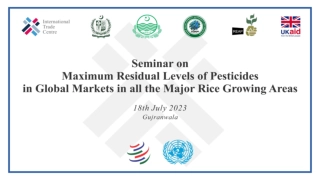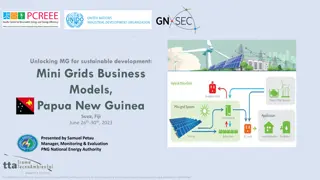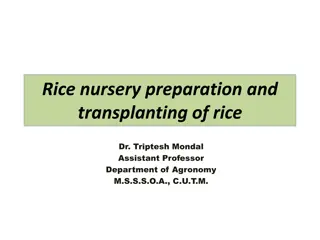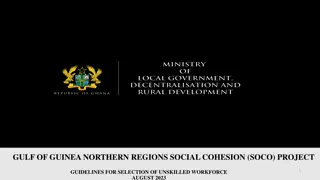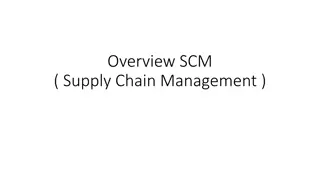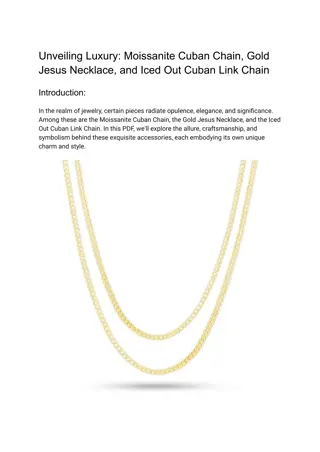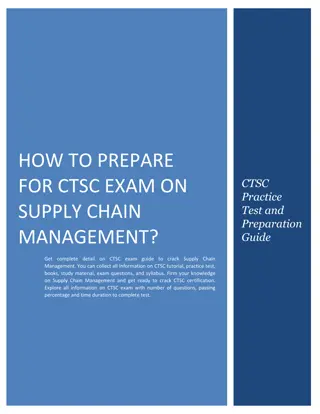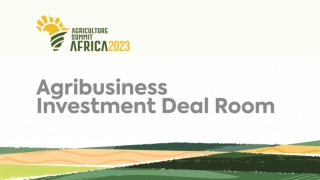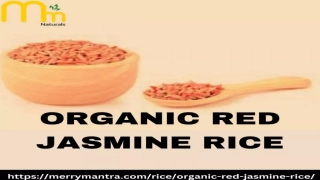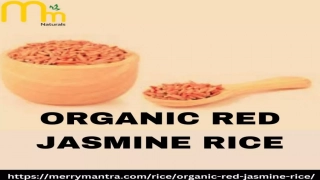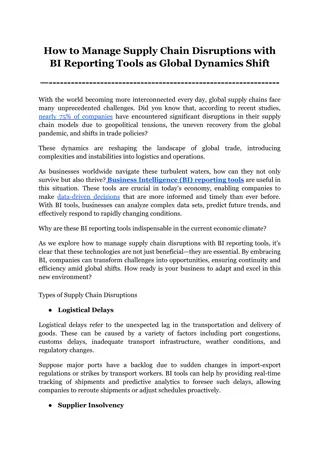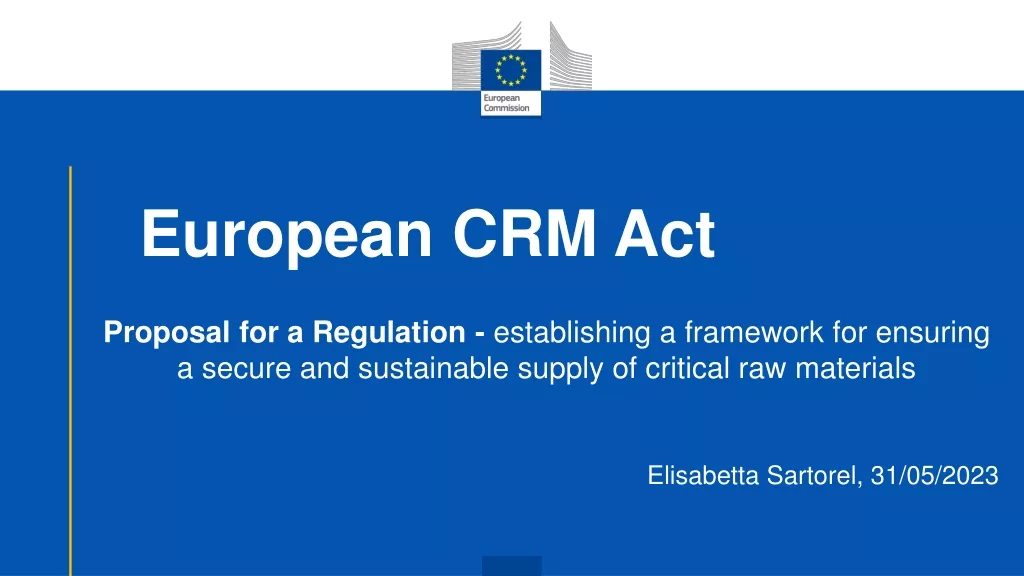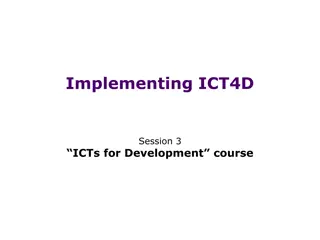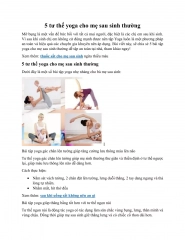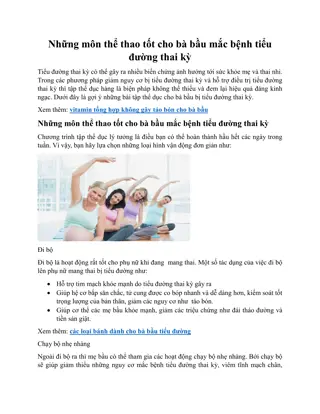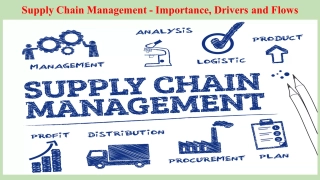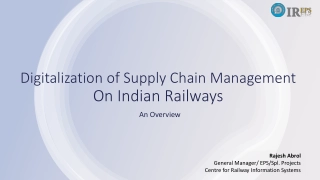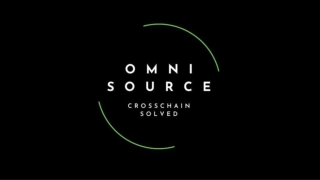Challenges in the Rice Value Chain in Guinea
Guinea faces various challenges in its rice value chain despite being a significant producer. The country's production has increased, but it still struggles to meet domestic demand, leading to substantial rice imports. Rice cultivation is vital for Guinea's socio-economic development, with over 80% of farms growing rice. The sector provides employment for a significant portion of the population and contributes to the GDP. Different rice production systems exist in Guinea, such as rainfed rice and lowland rice cultivation. Addressing these challenges is crucial for improving food security and the economy.
Challenges in the Rice Value Chain in Guinea
PowerPoint presentation about 'Challenges in the Rice Value Chain in Guinea'. This presentation describes the topic on Guinea faces various challenges in its rice value chain despite being a significant producer. The country's production has increased, but it still struggles to meet domestic demand, leading to substantial rice imports. Rice cultivation is vital for Guinea's socio-economic development, with over 80% of farms growing rice. The sector provides employment for a significant portion of the population and contributes to the GDP. Different rice production systems exist in Guinea, such as rainfed rice and lowland rice cultivation. Addressing these challenges is crucial for improving food security and the economy.. Download this presentation absolutely free.
Presentation Transcript
Challenges in the Rice Value Chain in Guinea
I. Geographical location of Guinea II. Context and importance of rice in Guinea III. Guinea's national rice development strategy (SNDR) Presentation Outline IV. Key players in the Guinean rice value chain V. Main challenges of the rice value chain in Guinea VI. Conclusion
Surface area is : 245 857 km2 Estimated population : 13,53 millions Agricultural and mining Country (rice production, Bauxite, Fer, Diamant, Gold ) I.1: I.1: Geograhical Geograhical location: Guinea location: Guinea is located in is located in West Africa West Africa
Rice is the staple food of the Guinean population. Its production rose significantly between 2008 and 2018, from 1,465,700 tonnes in 2008/2009 to 2,340,000 tonnes in 2017/2018. This increase is due to an increase in the area planted thanks to government support for the sector (research, extension, development, tracks, mechanization, inputs, organization and training of producers, etc.). II.1 Rice context II.1 Rice context in Guinea in Guinea Despite this good performance, rice production is still unable to meet the population's consumption needs. The shortfall is made up by massive imports, which rose from 261,000 tonnes in 2010 to 604,000 tonnes in 2017. This situation is exacerbated by the increase in per capita consumption, which rose from 100 kg in 2010 to 120 kg in 2017, bringing milled rice requirements by 2030 to almost 3,000,000 tonnes for a population estimated at almost 25,000,000.
Rice growing plays a key role in Guinea's socio-economic development. In fact: rice is grown by over 80% of farms and ccupies more than 65% of sown areas; Rice generates employment for over 30% of the working population; Per capita rice consumption is among the highest on the African continent ; It Contributes 6% to gross domestic product (GDP); Most production is carried out by small-scale producers. Substantial rice imports, with nearly USD 400 million spent on rice imports per year. II.2 The II.2 The Importance of Importance of Rice in Guinea Rice in Guinea
1. Rainfed rice: 60% of national production with average yields of 1 t/ha (in all four natural regions)La riziculture de Bas-fond : 10% of national production with yields of 1.5 to 2.5 t/ha (in all four natural regions, but more in Guin e Foresti re) and mostly one crop per year; II.3 Four II.3 Four main rice main rice production production systems in systems in Guinea Guinea(1) (1)
1. Rainfed rice: 60% of national production with average yields of 1 t/ha (in all four natural regions)La riziculture de Bas-fond : 10% of national production with yields of 1.5 to 2.5 t/ha (in all four natural regions, but more in Guin e Foresti re) and mostly one crop per year; II.3 II.3 Four main Four main rice production rice production systems in systems in Guinea Guinea 2. Mangrove rice: yields of 4 t/ha (only in Guin e Maritime) 3. Alluvial plain rice: yields of 1.5 to 2.5 t/ha (in all four natural regions, but more so in Upper Guinea). 4. The varieties grown are medium- to long-cycle (5 to 9 months).
2. Lowland rice: 10% of national production with yields of 1.5 to 2.5 t/ha (in all four natural regions, but more in Forest Guinea) and mostly one crop per year. II.3 Four II.3 Four main rice main rice production production systems in systems in Guinea Guinea(2) (2)
1. Rainfed rice: 60% of national production with average yields of 1 t/ha (in all four natural regions)La riziculture de Bas-fond : 10% of national production with yields of 1.5 to 2.5 t/ha (in all four natural regions, but more in Guin e Foresti re) and mostly one crop per year; II.3 II.3 Four main Four main rice production rice production systems in systems in Guinea Guinea 2. Mangrove rice: yields of 4 t/ha (only in Guin e Maritime) 3. Alluvial plain rice: yields of 1.5 to 2.5 t/ha (in all four natural regions, but more so in Upper Guinea). 4. The varieties grown are medium- to long-cycle (5 to 9 months).
1. Rainfed rice: 60% of national production with average yields of 1 t/ha (in all four natural regions)La riziculture de Bas-fond : 10% of national production with yields of 1.5 to 2.5 t/ha (in all four natural regions, but more in Guin e Foresti re) and mostly one crop per year; II.3 II.3 Four main Four main rice production rice production systems in systems in Guinea Guinea 2. Mangrove rice: yields of 4 t/ha (only in Guin e Maritime) 3. Alluvial plain rice: yields of 1.5 to 2.5 t/ha (in all four natural regions, but more so in Upper Guinea). 4. The varieties grown are medium- to long-cycle (5 to 9 months).
1. Rainfed rice: 60% of national production with average yields of 1 t/ha (in all four natural regions)La riziculture de Bas-fond : 10% of national production with yields of 1.5 to 2.5 t/ha (in all four natural regions, but more in Guin e Foresti re) and mostly one crop per year; II.3 II.3 Four main Four main rice production rice production systems in systems in Guinea Guinea 2. Mangrove rice: yields of 4 t/ha (only in Guin e Maritime) 3. Alluvial plain rice: yields of 1.5 to 2.5 t/ha (in all four natural regions, but more so in Upper Guinea). 4. The varieties grown are medium- to long-cycle (5 to 9 months).
Overall objective: Ensure the country's self-sufficiency in rice in the medium term and export to sub-regional and international markets in the longer term. Quantified specific objectives: increase production from 2,340,000 tonnes in 2018 to 5,000,000 tonnes in 2030 increase average rice yields from 1.17 t/ha in 2017 to 6.6 tonnes in 2030; III. National III. National Strategy Strategy (SNDR) (SNDR) develop with total water control by 2030, increase the use of certified seeds from 12% to 30%. increase mechanization in the sector from 22% to 40%; strengthen processing capacities so that 80% of paddy produced is processed using modern methods (industrial and/or semi-industrial) Increase the number of supervisors in the sector from one technician for every 150 rice growers to one technician for every 80 rice growers by 2030 (equivalent to doubling the number of supervisors in the rice sector).
Rice producers Input sellers CollectorsProcessors Net rice sellers (wholesalers and retailers) State support services (agricultural advisory services, quality control, plant and stored product protection, agronomic research, etc.) Programs and projects (WFP - resilience project/local purchases, IFAD) Consumers IV. IV. The main The main actors in actors in Guinea's rice Guinea's rice value chain value chain
Rice production, Rice production, assembly markets assembly markets marketing marketing
The main challenges facing rice production Land management for rice production; Water management; Use of adapted, high-yield seeds; Support for varietal creation (national, sub-regional); Dissemination of good rice-growing practices; Pest control and management; mechanization; Access to inputs (fertilizers and pesticides); Maintaining the local workforce (rural exodus, particularly among young people (to mining areas or big cities); Main Main challenges challenges for Guinea's for Guinea's rice value rice value chain (1) chain (1)
Les principaux dfis relever pour la production rizicole :The main challenges facing rice production L am nagement des terres pour la production rizicole ; La ma trise / gestion de l eau ; L utilisation de semences adapt es et haut rendement ; Le soutien la cr ation vari tale (national, sous- r gional) ; La diffusion de bonnes pratiques rizicoles ; La Ma trise et gestion des nuisibles ; La m canisation; L acc s aux intrants (engrais et pesticides); Le maintien de la main d uvre locale (ph nom ne d exode rural, notamment chez les jeunes (vers les zones mini res ou les grandes villes); Main Main challenges challenges for Guinea's for Guinea's rice value rice value chain (1) chain (1)
Les dfis pour la collecte du riz : Les collectes de riz par cologie et vari t s (caract ristiques physiques et organoleptiques, etc.) L enclavement des zones de production; Le Stockage et conservation du paddy; Principaux Principaux d fis de la d fis de la cha ne de cha ne de valeur du riz valeur du riz en Guin e (2) en Guin e (2) D fis pour la transformation du riz : Passage de syst mes de transformation artisanaux vers des syst mes am lior s d tuvage pour une meilleure qualit et productivit ; Duplication des centres de transformation / plate- forme multifonctionnelles (exemple WAAPP) ; Promotion des unit s de transformation modernes adapt es (rizerie); Le conditionnement et l emballage du riz transform (riz net) Stockage et conservation du riz net;
Dfis pour la commercialisation Faible lab lisation du riz transform ; Commercialisation du riz selon le type d cologie; Principaux Principaux d fis d fis de la de la cha ne cha ne de valeur valeur du en en Guin e (3) Guin e (3) D fis pour l organisation des acteurs de chaine de valeur riz D fis pour l acc s aux cr dit des acteurs de la chaine de valeur: Structuration des organisations de producteurs et autres acteurs en des Coop ratives ; Mise en relation (contractualisation) des acteurs des maillons de la Cha ne de valeur du riz en Guin e ; Des cr dits de campagne adapt s des taux bonifi s pour les acteurs en esp ces comme en quipements; Manque de garanties pour l acc s aux cr dits; Taux lev des cr dits de du riz riz D fis de la r glementation des produits phytosanitaires et engrais : Homologation des produits phytosanitaires et des engrais par les structures comp tentes ;
Malgr les immenses potentialits agro-climatique et cologiques favorables a l agriculture, la production rizicole Guin enne ne couvre pas encore 100% des besoins alimentaires du pays qui reste d pendant de l importation. Le riz est une denr e strat gique dans le d veloppement socio- conomique de la Guin e. La fili re a besoin d un renforcement chaque maillon de la chaine de valeur pour devenir comp titive sur les march s internationaux et lucrative pour les acteurs de la cha ne. Conclusion


